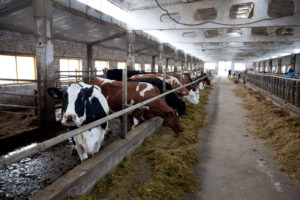Bird flu: EU tracks virus mutations and reviews response strategy

 Express-tests PIONER 5 in1 for the determination of thiamphenicol, meloxicam, colistine, trimethoprim, sulfonamides
Express-tests PIONER 5 in1 for the determination of thiamphenicol, meloxicam, colistine, trimethoprim, sulfonamides PIONEER MEIZHENG BIO-TECH (5 in1) JC1165 / Rapid tests for the determination of the residual amount of halofuginone, flavomycin, novobiocin, flunixin, dexamethasone / prednisolone in milk, whey
PIONEER MEIZHENG BIO-TECH (5 in1) JC1165 / Rapid tests for the determination of the residual amount of halofuginone, flavomycin, novobiocin, flunixin, dexamethasone / prednisolone in milk, whey
As part of the One HEALTH approach, the European Centre for Disease Prevention and Control (ECDC) and the European Food Safety Authority (EFSA) have published scientific advice on assessing avian influenza virus mutations and their potential for spread to humans, as well as recommendations for public health and veterinary authorities.
The work of both agencies relies on extensive data, including genetic analysis, human case studies , and antibody testing, to determine current risks and mitigation strategies.
Pamela Rendi-Wagner, DIRECTOR of ECDC, stated: "Global developments require us to remain vigilant and ensure Europe is prepared to respond to the threat of avian influenza. ECDC helps EU and EEA Member States prepare for, prevent, and contain potential future outbreaks in animals and humans. Having robust preparedness plans is crucial to protecting public health in Europe."
"In 2024 , avian influenza viruses expanded their range and infected previously unaffected species. Our work identifies key mutations associated with the potential spread of the virus to humans, requiring rapid detection and response. Cooperation and data sharing between all stakeholders remain critical to responding to emerging situations," said Bernhard Url, Acting Executive Director of EFSA.
Experts have compiled a comprehensive list of mutations, identifying 34 genetic mutations that could increase the likelihood of avian influenza virus transmission to humans. Using molecular analysis and genomic surveillance, public health and veterinary laboratories can consult this constantly updated list of mutations to monitor for the emergence of strains that could be transmitted to humans.
The scientific opinion also examines how the adaptation of avian influenza viruses to mammals may be driven by factors such as genetic mutations, the mixing of genetic material between viruses, and interactions with the host immune response. it also examines external factors that may increase the likelihood of virus transmission to humans, such as human activities and environmental changes leading to increased contact between wild animals, poultry, livestock, and people. High-density agriculture , inadequate biosecurity measures, deforestation, urbanization, and global trade increase the risk of virus transmission from animals to humans.
Key recommendations regarding avian influenza mutations
Genetic analysis: Use genetic sequencing to identify early mutations or viral adaptations to mammals. Invest in systems to quickly identify new viruses and mutations that allow them to spread from animals to humans.
Animal surveillance: Monitoring sick or dead mammals associated with infected birds, poultry, or wild mammals. Monitoring for unexplained illnesses during high-risk periods and in areas with avian influenza.
Public health surveillance: testing individuals exposed to the virus and regularly submitting samples to more accurately identify influenza subtypes. During animal outbreaks, hospitals should strengthen surveillance and monitoring, especially during peak influenza seasons, when the risk of genetic mixing between viruses increases.
Preventive measures: Implement robust biosecurity measures on farms, train staff, vaccinate poultry, and develop outbreak response plans. Ensure compliance with influenza vaccination and antiviral treatment recommendations for at-risk individuals.
Public health preparedness measures: Raise awareness among high-risk groups and the general population, and train health workers in recognizing and treating avian influenza. Ensure coordinated plans for responding to human cases. Develop guidelines and standard operating procedures for testing exposed individuals and contacts of patients, including preventive protocols. Ensure coordinated plans for responding to human cases are integrated into national prevention, preparedness, and response plans.
Along with scientific recommendations, the agencies also developed guidance for investigating and managing avian influenza outbreaks affecting both humans and animals, using a coordinated "One Health" approach. Experts developed flowcharts outlining response measures for five outbreak scenarios at the interface of humans, animals, and the environment, emphasizing the importance of a multidisciplinary approach among all stakeholders. This work will help Member States develop tailored national recommendations.
Read together with it:
- The Russian Ministry of Agriculture proposes extending veterinary regulations until 2032.The extension includes regulations for the prevention and eradication of diseases such as bradsot (Clostridium septicum), trichinosis (Trichinella), blackleg (Clostridium chauvoei), and porcine reproductive and respiratory syndrome (PRRS). The proposed changes stipulate the following new deadlines: for bradsot and trichinosis - from March 1, 2......
- An HSE expert reported on the "evolution of inequality" in access to healthcare.An HSE researcher analyzed Russians' access to healthcare over a ten-year period. In 2021, the influence of financial factors became noticeable for the first time: low income reduces the likelihood of visiting a DOCTOR.Over the ten years from 2011 to 2021, the number of Russians requiring medical care but not receiving it remained virtually unchanged, according to a study by Lyudmila Zasimova, hea...
- Belstat reported how much grain, milk, meat, and vegetables are produced in Belarus per capita.November 14, MINSK . Belarus produces 913 kg of grain, 958 kg of MILK, 341 kg of potatoes, and 304 kg of vegetables per capita, according to a review by the National Statistical Committee for the Day of Agricultural and Processing Industry Workers, BELTA reports. The country also produces 78 kg of fruits and berries, 147 kg of livestock and poultry (slaughter weight), and 4......
- UniCredit заявил о галактических усилиях из-за санкций против РоссииUniCredit старается не нарушить «более 15 тыс. санкций», а также не «совершать ошибки», которые позволят изъять его активы в России, заявил гендиректор. После начала военной операции банк начал рассматривать возможность ухода Итальянский банк UniCredit прилагает «галактические усилия», пытаясь соблюсти международные санкции в отношении своего российского подразделения. Об этом заявил генеральный д...
- "Коллективы АПК способны решать любые задачи даже в непростых условиях". Назаров о заслугах сельхозпроизводителейЮрий Назаров 13 ноября, Минск. Обеспечение продовольственной безопасности страны - большое достижение трудовых коллективов аграриев, отметил управляющий делами Президента Республики Беларусь Юрий Назаров на торжественной церемонии награждения государственными и иными наградами работников АПК Управления делами Президента Республики Беларусь, передает корреспондент БЕЛТА. Торжественная церемония наг...
























































